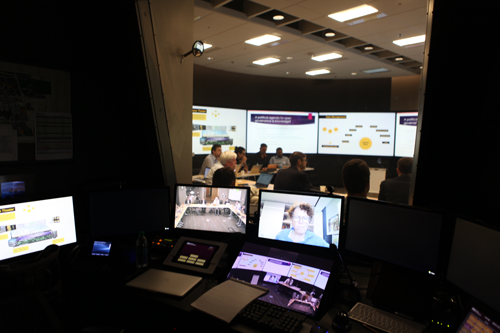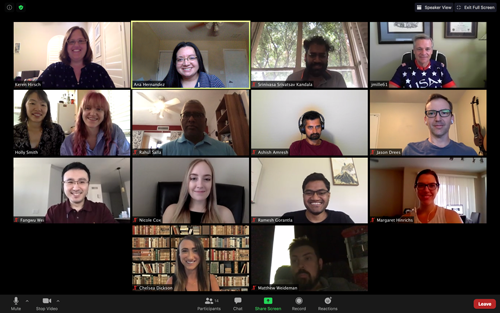Decision Theater Is More Than a Room: The Seamless Transition to a Virtual Environment
In the wake of the pandemic, people have been forced to make drastic adjustments to their daily lives. Places of business needed to make strategic operational choices quickly. When, how, and why changes are made in the face of adversity can speak volumes about the true values of an organization. Since its conception, creating meaningful avenues for collaboration has always been a central mission at Decision Theater (DT). It was clear in the early days of COVID-19 that eliminating physical contact did not equate to sacrificing vital connections externally, nor internally.
 The sophisticated technological capabilities of DT exist to enhance the decision-making process for diverse stakeholders. When many people think of engagements at DT, they think of meeting in the ‘Drum,’ the visually immersive seven-screen room in the Decision Theater that hosts stakeholders and policy makers. This room presents multiple ways to engage with a complex problem. While in-person contact among stakeholders cannot be overlooked, the design of the technology that drives the collaboration in the ‘Drum’ allows the engagements to happen anywhere in the world as long as high-speed internet is available. The integrated models are primarily browser-based, opening access to participants that can join and interact with the models remotely. The ability to be in the ‘Drum’ with a 270-degree modality provided by the seven screens has an element of immersion that cannot be reproduced in virtual setting. However, the technology takes advantage of web-based interfaces in building highly intuitive and engaged single screen versions of the models with very little loss in function and fidelity. In addition, the seven-screen set up of the Drum can be mirrored with any array of devices, including monitors, iPhones, and even multiple browser tabs within a single screen. This allows for the creation of a portable or mobile DT. The versatility of this can be valuable in rural settings that lack the infrastructure or the bandwidth to support virtual engagements.
The sophisticated technological capabilities of DT exist to enhance the decision-making process for diverse stakeholders. When many people think of engagements at DT, they think of meeting in the ‘Drum,’ the visually immersive seven-screen room in the Decision Theater that hosts stakeholders and policy makers. This room presents multiple ways to engage with a complex problem. While in-person contact among stakeholders cannot be overlooked, the design of the technology that drives the collaboration in the ‘Drum’ allows the engagements to happen anywhere in the world as long as high-speed internet is available. The integrated models are primarily browser-based, opening access to participants that can join and interact with the models remotely. The ability to be in the ‘Drum’ with a 270-degree modality provided by the seven screens has an element of immersion that cannot be reproduced in virtual setting. However, the technology takes advantage of web-based interfaces in building highly intuitive and engaged single screen versions of the models with very little loss in function and fidelity. In addition, the seven-screen set up of the Drum can be mirrored with any array of devices, including monitors, iPhones, and even multiple browser tabs within a single screen. This allows for the creation of a portable or mobile DT. The versatility of this can be valuable in rural settings that lack the infrastructure or the bandwidth to support virtual engagements.
 At the core of the cutting-edge technology is the belief that transdisciplinary cooperation driven by data is necessary in tackling complex issues; this technology exists to enable conversations between policymakers and subject-matter experts to occur. DT swiftly made the choice to move all engagements online to do their part in slowing the spread of COVID, while still making it possible for projects and partnerships to progress. Video calls, virtual overviews and model demonstrations allow for the continuation of significant collaboration. This in turns empowers stakeholders to keep co-creating and discussing innovative solutions to real-world problems, including several projects related to the current pandemic. For example, DT has been working with health experts in building models that can provide better access and care for tribal and rural settings such as the Navajo Nation, where the pandemic has disproportionately affected the population. Also, DT has been tracking COVID-19 and Coronavirus-based messaging on Twitter. Since March 9th, over six million tweets have been collected; these Tweets can help researchers with social media analytics as it relates to the spread of the virus.
At the core of the cutting-edge technology is the belief that transdisciplinary cooperation driven by data is necessary in tackling complex issues; this technology exists to enable conversations between policymakers and subject-matter experts to occur. DT swiftly made the choice to move all engagements online to do their part in slowing the spread of COVID, while still making it possible for projects and partnerships to progress. Video calls, virtual overviews and model demonstrations allow for the continuation of significant collaboration. This in turns empowers stakeholders to keep co-creating and discussing innovative solutions to real-world problems, including several projects related to the current pandemic. For example, DT has been working with health experts in building models that can provide better access and care for tribal and rural settings such as the Navajo Nation, where the pandemic has disproportionately affected the population. Also, DT has been tracking COVID-19 and Coronavirus-based messaging on Twitter. Since March 9th, over six million tweets have been collected; these Tweets can help researchers with social media analytics as it relates to the spread of the virus.
 Internal relations at DT have also remained strong despite physical convergence spaces being closed. The sense of community within staff has not faltered during this time – largely due to the persistence and creativity of leadership. Since working from home began, daily activities and weekly virtual get-togethers have been incorporated into the standard work routine. In addition, wellness challenges have enforced the idea that mental, physical and relationship health are top priorities. Wellness meetings act as a safe-space to discuss the ups and downs of the week. These various events have proven to be impactful outlets for expressing frustrations or feelings of uncertainty in quarantine. The systems in place help create a sense of support and togetherness that undoubtedly has a positive impact on the morale and work within DT. While there have been many instances of businesses struggling to adapt to the new normal imposed by the pandemic, DT is a shining example of how institutions and organizations should look at adapting and operating – while not compromising on the health and safety of their employees.
Internal relations at DT have also remained strong despite physical convergence spaces being closed. The sense of community within staff has not faltered during this time – largely due to the persistence and creativity of leadership. Since working from home began, daily activities and weekly virtual get-togethers have been incorporated into the standard work routine. In addition, wellness challenges have enforced the idea that mental, physical and relationship health are top priorities. Wellness meetings act as a safe-space to discuss the ups and downs of the week. These various events have proven to be impactful outlets for expressing frustrations or feelings of uncertainty in quarantine. The systems in place help create a sense of support and togetherness that undoubtedly has a positive impact on the morale and work within DT. While there have been many instances of businesses struggling to adapt to the new normal imposed by the pandemic, DT is a shining example of how institutions and organizations should look at adapting and operating – while not compromising on the health and safety of their employees.
By April Kim

